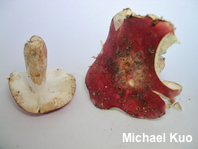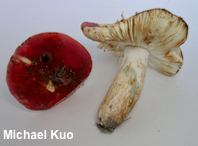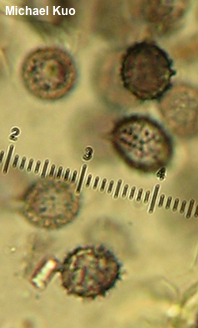| Major Groups > Gilled Mushrooms > Pale-Spored > Russula > Shrimp Russulas > Russula fucosa |

|
[ Basidiomycota > Russulales > Russulaceae > Russula . . . ] Russula fucosa by Michael Kuo, 2 October 2025 My guess is that I have seen this eastern North American, hardwood-associated shrimp russula many more times than I have collected it (which is only once) because, well, it's a red russula. There are soooo many of them. Yes, they're pretty. But figuring out what they are is usually a quixotic adventure, and the truth is, I retired my lance and donkey long ago. But something possessed me to collect the mushroom described and illustrated here, now almost 20 years ago. Apparently I was too lazy to take photos in the woods, but I did at least photograph some specimens at home and take notes—and the details soon began to separate this mushroom from the hordes of red russulas. There was an odor of shrimp. The surfaces stained brown when bruised. The stem turned green with iron salts. These are the hallmarks of the Russula xerampelina, or "shrimp russula," group. Among the shrimp russulas, Russula fucosa can be separated on the basis of its association with eastern North American oaks or beech, and its red, rather than purple, cap. Red for Russula fucosa, purple for Russula atropurpurea, which is also associated with eastern hardwoods. That's the theory, anyway, but russula species are notorious for manifesting highly variable cap colors. According to some authors there is a difference in the morphology of the terminal hyphae of the pileipellis, but only if you examine material near the edge of the cap. Have fun. Meanwhile, I suspect these differences may result from environmental conditions, maturation stages, and specimen selection rather than speciation. Although Russula fucosa was originally described as occurring in "moist woods of beech and spruce" (Burlingham 1924), it is highly likely that the species was associated with the beech rather than spruce; subsequent collections, when sufficiently documented, always include members of the Fagaceae (beech and oaks), but only occasionally mention conifers (usually eastern hemlock, which often appears in mixed woods with beech or oaks). Description: Ecology: Mycorrhizal with oaks and beech; growing alone or gregariously; summer and fall; originally described from Vermont (Burlingham 1924); widely distributed east of the Great Plains in the United States and Canada. The illustrated and described collection is from Illinois. Cap: 4–6 cm; convex, becoming broadly convex; very finely velvety at first, becoming bald; sticky when fresh; the cuticle peeling easily about one-fourth the distance from the margin to the center; bright red to purplish red; the margin not lined. Gills: Narrowly attached to the stem; close; short-gills infrequent; whitish, becoming dull yellow; bruising brown. Stem: 3–4.5 cm long; 1–1.5 cm thick; equal; dry; bald; white, bruising brown. Flesh: White; staining slowly brownish when sliced. Odor and Taste: Odor shrimp-like; taste not distinctive. Chemical Reactions: Iron salts on stem surface green. Microscopic Features: Spores 7–10 x 6–8 µm including ornamentation; ellipsoid; ornamentation as amyloid, isolated warts 0.5–1.0 µm high, with only a few scattered connectors; not reticulate. Pleurocystidia 40–60 x 8–12 µm; fusiform, occasionally with an apical knob; smooth; thin-walled; contents granular; hyaline in KOH. Pileipellis an ixocutis; elements 2–4 µm wide, smooth, hyaline in KOH; pileocystidia present. REFERENCES: G. Burlingham, 1924. (Hesler, 1961; Adamčík & Buyck, 2011; Buyck & Adamčík, 2013; Noffsinger et al., 2024.) Herb Kuo 07140706. This site contains no information about the edibility or toxicity of mushrooms. |
© MushroomExpert.Com |
|
Cite this page as: Kuo, M. (2025, October). Russula fucosa. Retrieved from the MushroomExpert.Com Web site: http://www.mushroomexpert.com/russula_fucosa.html |


